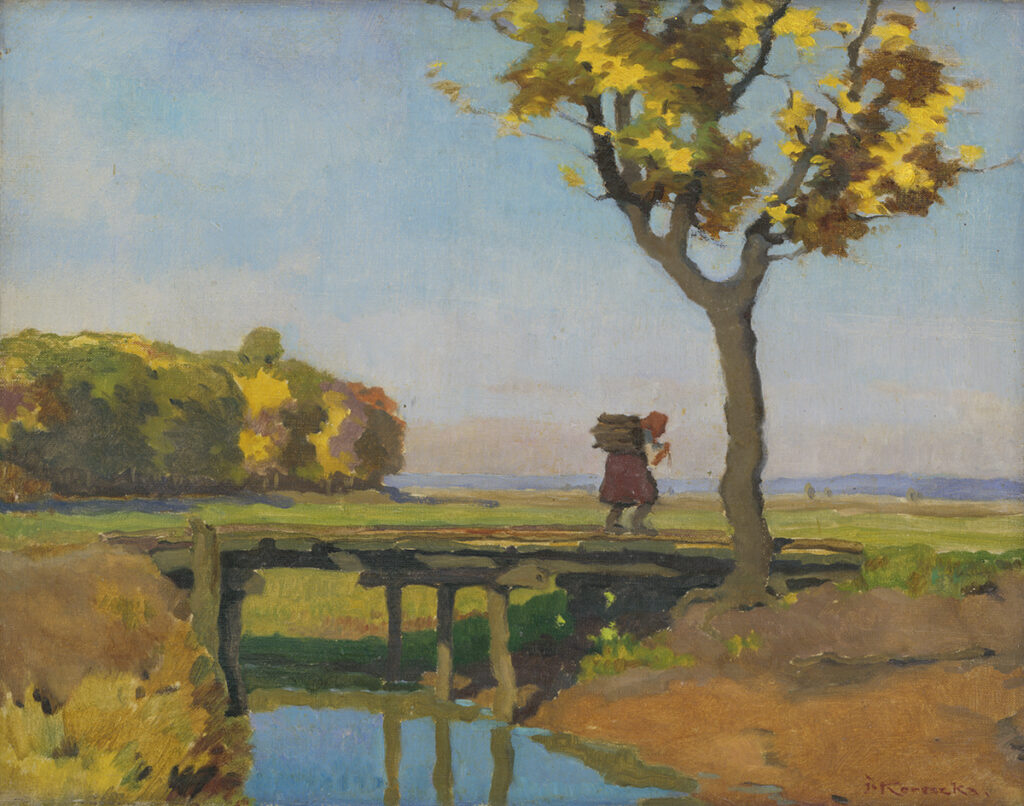The composition of the work Jeseň (Autumn) leads viewers in a quiet, melancholic, flat landscape dressed in golden hues of a late summer afternoon, radiating energy and dynamics. The work envelops the viewer with the atmosphere created by an old wooden bridge whose shadow reflects in the still surface of a stream, an isolated tree, torn by the wind, rain and burning sun silently reveals its broken branches barren of leaves that are as if a cry of hurt nature on the background of grey and blue sky. The narrative is complemented by a figure of a woman dressed in rural, everyday clothes, a red scarf on her head, dark brown linen skirt on. The woman is slightly bowed under the burden of collected sticks, she heads home, tired and weary. Looking at her makes the viewer feel pity for her life, certainly poor and humble, the same as everyday routine rural people in the period of economic crises experience. This genre, slightly expressive composition is calm, its soothing colours transfer the viewer from the experienced moment into the past of the Slovak land and its people.
Július Koreszka is known as a painter, mostly the landscape painter of melancholic mood. Quiet lyricisms, postimpressionist poeticizing of nature together with a specific feeling for a decorative rendition of reality are characteristics for his works.
Július Koreszka was born on February 24, 1985 in Dojč, in the district of Senica in Slovakia. He started his studies at the Academy of Fine Arts in Budapest, however, his studies were interrupted by the war in 1914. After the war he continued in his studies at the Prague Academy (1919 -1924) together with Janko Alexy and M.A.Bazovsky. In 1925 he visited Paris to study there. From the mid 1920s, from the moment he emerged in the Slovak art scene we can follow him painting the world of quiet, reticent flatlands and lowlands from the Bratislava surroundings where he lived after finishing his studies. In 1926 – 1927 he was the member of the Slovak Artistic Circle and he had his first exhibition in 12th membership exhibition of the Slovak Artistic Circle. Two years later he became the member of the Slovak Artists Association and he regularly participated in the exhibitions of the Association.
Later in the second half of the thirties, he built the studio in the family estate in the old region of his ancestors: Skalica, and he worked in the quiet Skalica area, undisturbed. During all his creative life this environment was a powerful source of inspiration for him. He often depicted picturesque panorama of the Skalica landscape and its town quiet corners. He also favoured in depicting hunting still-lives. Towards the end of his life he devoted his time to historical and religious motives, dominated by figurative appendage.
His works can be found in acquisition funds of Slovak museums and galleries and in private collections of art collectors who admired of his landscape painting.
Július Korezska died on December 1, 1958. On the occasion to commemorate 10 years from the author’s death the exhibition opened in the Nitra Gallery, where Danica Zmetáková said the following: “The author always modestly with a lyrical tilt and gift for creating a mood poetically conveyed his subject matters. Big gestures or exaltations were strange to him. Quiet atmosphere dominates his paintings, there are neither tensions nor conflicts.
— Marta Hučková
Secondary Sources
Váross, M.: Slovenské výtvarné umenie 1918-1945, SVKL Bratislava, 1960, p. 118-122
Zmetáková, D.: Július Korezska, catalogue, Nitrianska galéria, 1968
Kolektív autorov: Dejiny slovenského výtvarného umenia – 20. storočie. In: Zdroj a zdroje maliarskej moderny 1900-1938. SNG Bratislava 2000, p. 67
Inventory No.: O 237
Author: Július Korezska
Title: Jeseň (Autumn)
Technique: oil
Material: canvas
Year: 1925 – 1935
Dimension: 30 × 38 cm
Marked: in the right bottom corner: Korezska
